Global Leadership: Nigeria's Culture, Theories, and Denmark's Dilemmas
VerifiedAdded on 2020/12/29
|12
|3750
|298
Report
AI Summary
This report provides an executive summary and detailed analysis of cultural and leadership aspects in Nigeria and Denmark. The study begins by examining Nigerian culture, including its hierarchical structure and gift-giving etiquette, and then explores two leadership theories—relationship and management theories—suitable for influencing project team leader behavior. The report also delves into project management approaches, comparing Agile and Waterfall methodologies, and discusses the importance of power balance and ethical practices in project management. Furthermore, it identifies dilemmas and problems leaders in Denmark might face, such as non-hierarchical organizations and gender preferences. The report concludes with a comparison of human capital development statistics between Nigeria and Denmark, offering insights into global leadership challenges and opportunities.
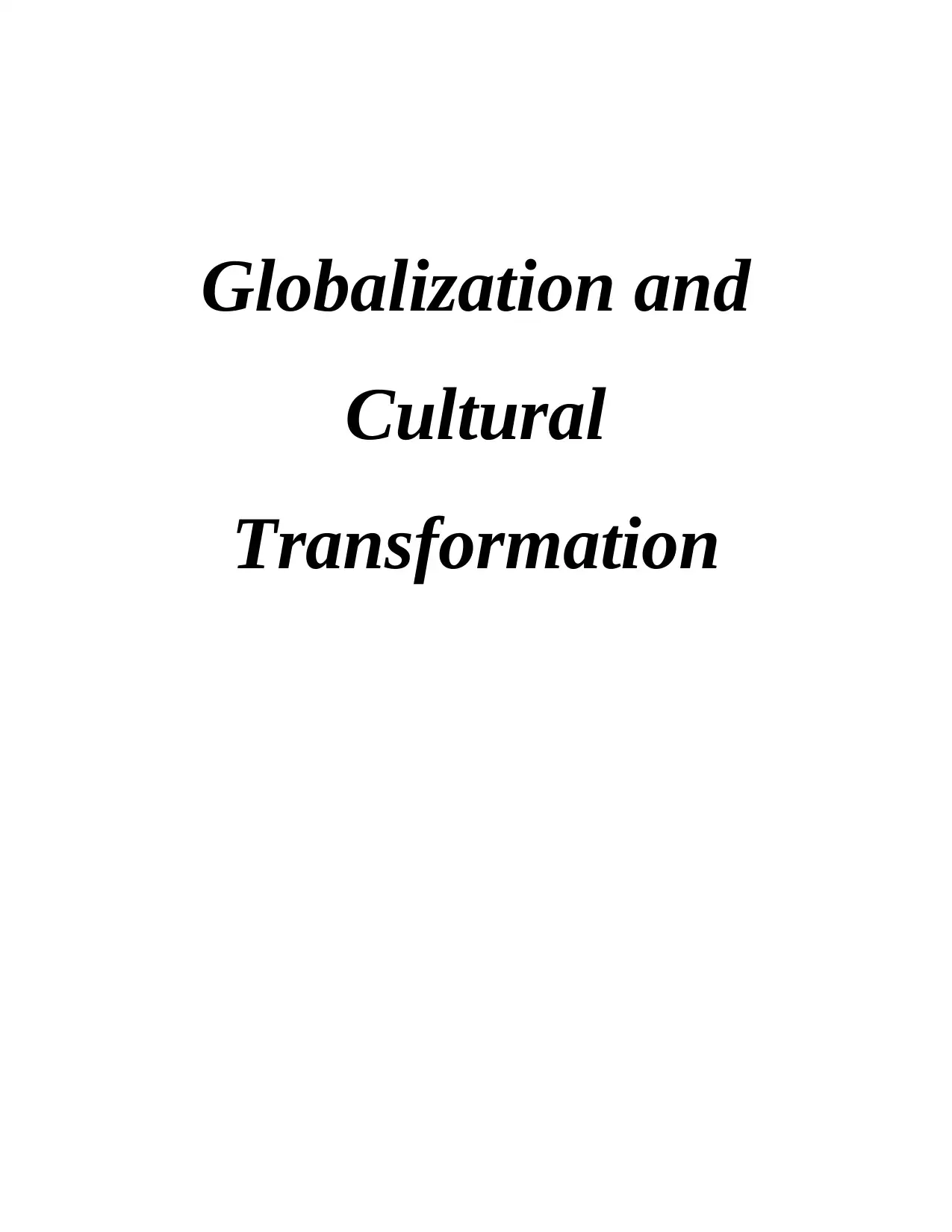
Globalization and
Cultural
Transformation
Cultural
Transformation
Paraphrase This Document
Need a fresh take? Get an instant paraphrase of this document with our AI Paraphraser
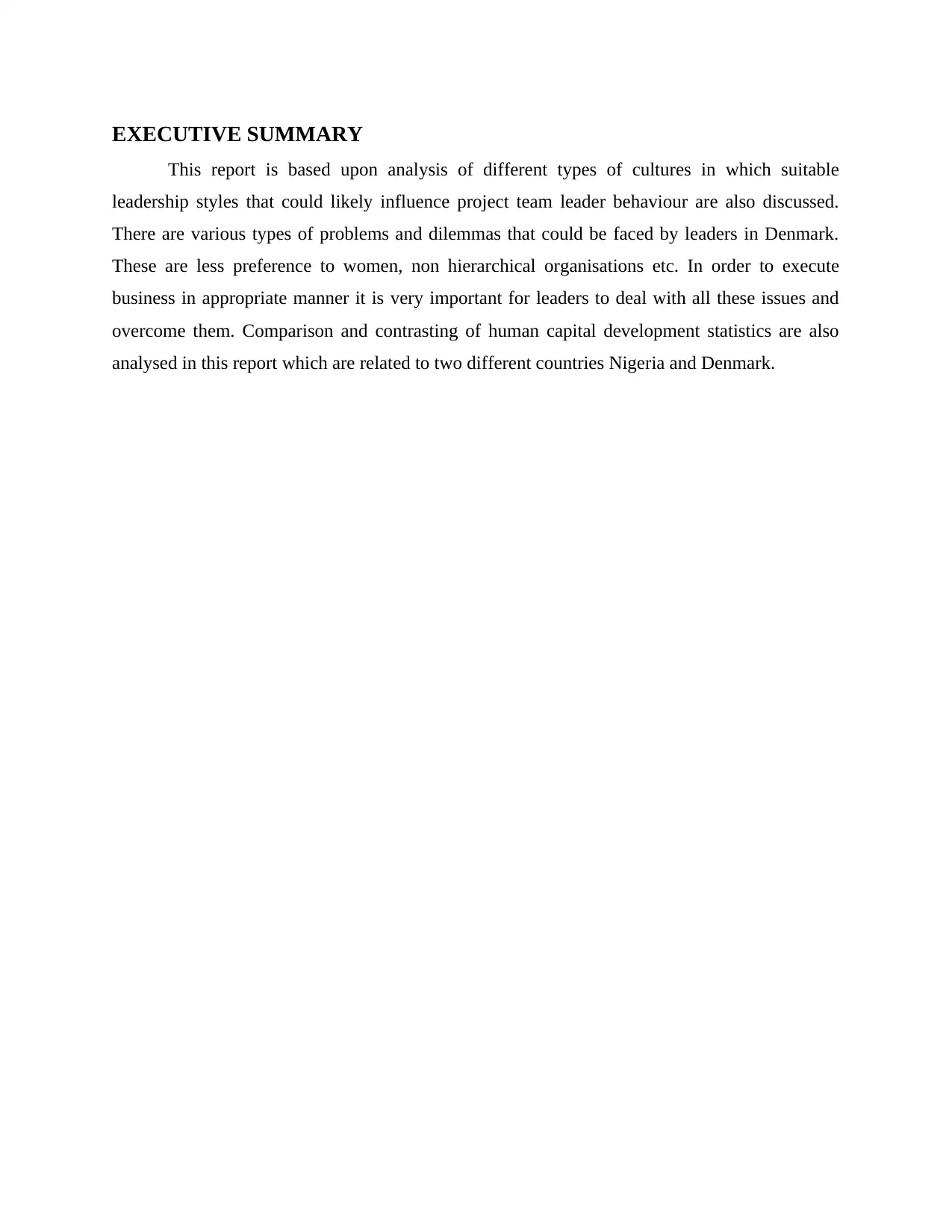
EXECUTIVE SUMMARY
This report is based upon analysis of different types of cultures in which suitable
leadership styles that could likely influence project team leader behaviour are also discussed.
There are various types of problems and dilemmas that could be faced by leaders in Denmark.
These are less preference to women, non hierarchical organisations etc. In order to execute
business in appropriate manner it is very important for leaders to deal with all these issues and
overcome them. Comparison and contrasting of human capital development statistics are also
analysed in this report which are related to two different countries Nigeria and Denmark.
This report is based upon analysis of different types of cultures in which suitable
leadership styles that could likely influence project team leader behaviour are also discussed.
There are various types of problems and dilemmas that could be faced by leaders in Denmark.
These are less preference to women, non hierarchical organisations etc. In order to execute
business in appropriate manner it is very important for leaders to deal with all these issues and
overcome them. Comparison and contrasting of human capital development statistics are also
analysed in this report which are related to two different countries Nigeria and Denmark.
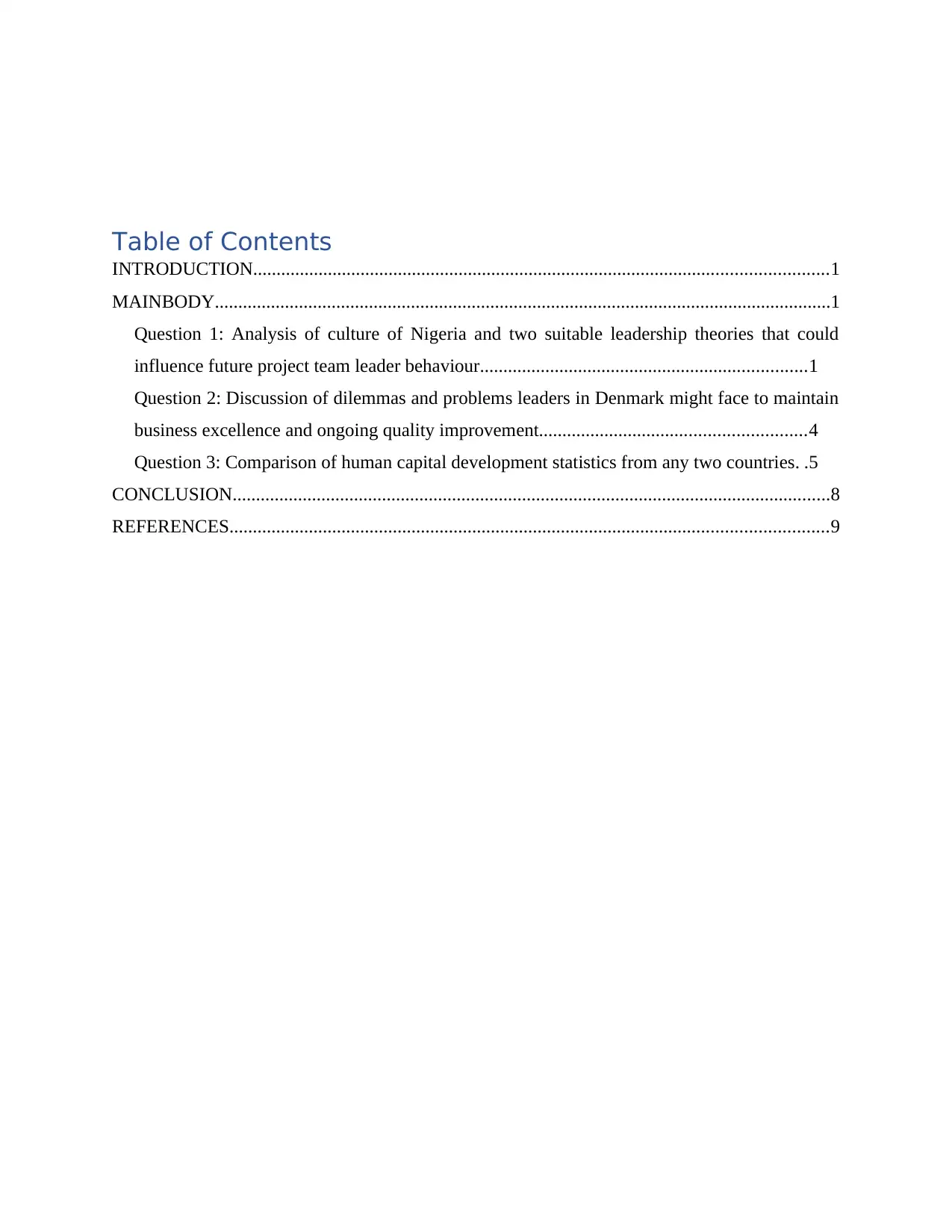
Table of Contents
INTRODUCTION...........................................................................................................................1
MAINBODY....................................................................................................................................1
Question 1: Analysis of culture of Nigeria and two suitable leadership theories that could
influence future project team leader behaviour......................................................................1
Question 2: Discussion of dilemmas and problems leaders in Denmark might face to maintain
business excellence and ongoing quality improvement.........................................................4
Question 3: Comparison of human capital development statistics from any two countries. .5
CONCLUSION................................................................................................................................8
REFERENCES................................................................................................................................9
INTRODUCTION...........................................................................................................................1
MAINBODY....................................................................................................................................1
Question 1: Analysis of culture of Nigeria and two suitable leadership theories that could
influence future project team leader behaviour......................................................................1
Question 2: Discussion of dilemmas and problems leaders in Denmark might face to maintain
business excellence and ongoing quality improvement.........................................................4
Question 3: Comparison of human capital development statistics from any two countries. .5
CONCLUSION................................................................................................................................8
REFERENCES................................................................................................................................9
⊘ This is a preview!⊘
Do you want full access?
Subscribe today to unlock all pages.

Trusted by 1+ million students worldwide
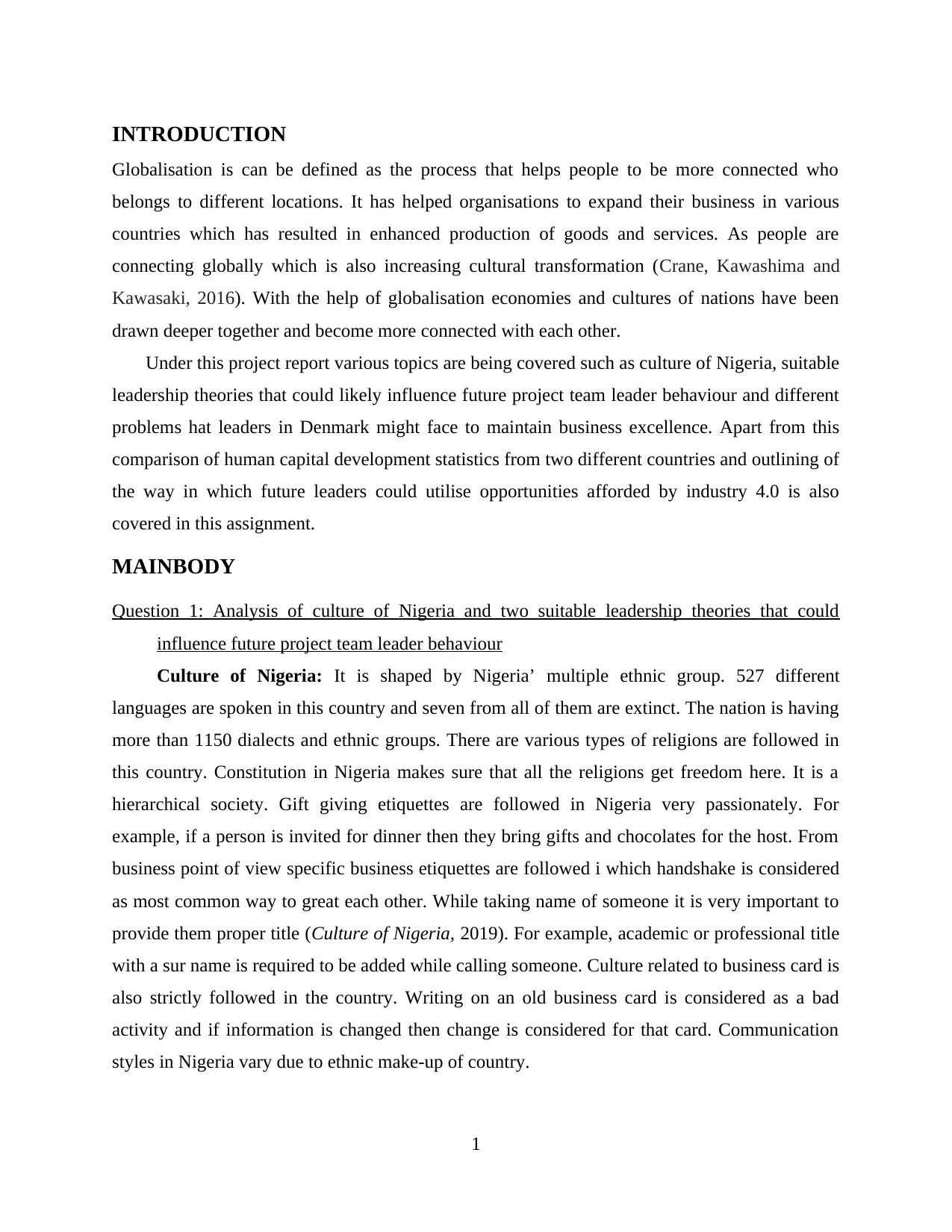
INTRODUCTION
Globalisation is can be defined as the process that helps people to be more connected who
belongs to different locations. It has helped organisations to expand their business in various
countries which has resulted in enhanced production of goods and services. As people are
connecting globally which is also increasing cultural transformation (Crane, Kawashima and
Kawasaki, 2016). With the help of globalisation economies and cultures of nations have been
drawn deeper together and become more connected with each other.
Under this project report various topics are being covered such as culture of Nigeria, suitable
leadership theories that could likely influence future project team leader behaviour and different
problems hat leaders in Denmark might face to maintain business excellence. Apart from this
comparison of human capital development statistics from two different countries and outlining of
the way in which future leaders could utilise opportunities afforded by industry 4.0 is also
covered in this assignment.
MAINBODY
Question 1: Analysis of culture of Nigeria and two suitable leadership theories that could
influence future project team leader behaviour
Culture of Nigeria: It is shaped by Nigeria’ multiple ethnic group. 527 different
languages are spoken in this country and seven from all of them are extinct. The nation is having
more than 1150 dialects and ethnic groups. There are various types of religions are followed in
this country. Constitution in Nigeria makes sure that all the religions get freedom here. It is a
hierarchical society. Gift giving etiquettes are followed in Nigeria very passionately. For
example, if a person is invited for dinner then they bring gifts and chocolates for the host. From
business point of view specific business etiquettes are followed i which handshake is considered
as most common way to great each other. While taking name of someone it is very important to
provide them proper title (Culture of Nigeria, 2019). For example, academic or professional title
with a sur name is required to be added while calling someone. Culture related to business card is
also strictly followed in the country. Writing on an old business card is considered as a bad
activity and if information is changed then change is considered for that card. Communication
styles in Nigeria vary due to ethnic make-up of country.
1
Globalisation is can be defined as the process that helps people to be more connected who
belongs to different locations. It has helped organisations to expand their business in various
countries which has resulted in enhanced production of goods and services. As people are
connecting globally which is also increasing cultural transformation (Crane, Kawashima and
Kawasaki, 2016). With the help of globalisation economies and cultures of nations have been
drawn deeper together and become more connected with each other.
Under this project report various topics are being covered such as culture of Nigeria, suitable
leadership theories that could likely influence future project team leader behaviour and different
problems hat leaders in Denmark might face to maintain business excellence. Apart from this
comparison of human capital development statistics from two different countries and outlining of
the way in which future leaders could utilise opportunities afforded by industry 4.0 is also
covered in this assignment.
MAINBODY
Question 1: Analysis of culture of Nigeria and two suitable leadership theories that could
influence future project team leader behaviour
Culture of Nigeria: It is shaped by Nigeria’ multiple ethnic group. 527 different
languages are spoken in this country and seven from all of them are extinct. The nation is having
more than 1150 dialects and ethnic groups. There are various types of religions are followed in
this country. Constitution in Nigeria makes sure that all the religions get freedom here. It is a
hierarchical society. Gift giving etiquettes are followed in Nigeria very passionately. For
example, if a person is invited for dinner then they bring gifts and chocolates for the host. From
business point of view specific business etiquettes are followed i which handshake is considered
as most common way to great each other. While taking name of someone it is very important to
provide them proper title (Culture of Nigeria, 2019). For example, academic or professional title
with a sur name is required to be added while calling someone. Culture related to business card is
also strictly followed in the country. Writing on an old business card is considered as a bad
activity and if information is changed then change is considered for that card. Communication
styles in Nigeria vary due to ethnic make-up of country.
1
Paraphrase This Document
Need a fresh take? Get an instant paraphrase of this document with our AI Paraphraser
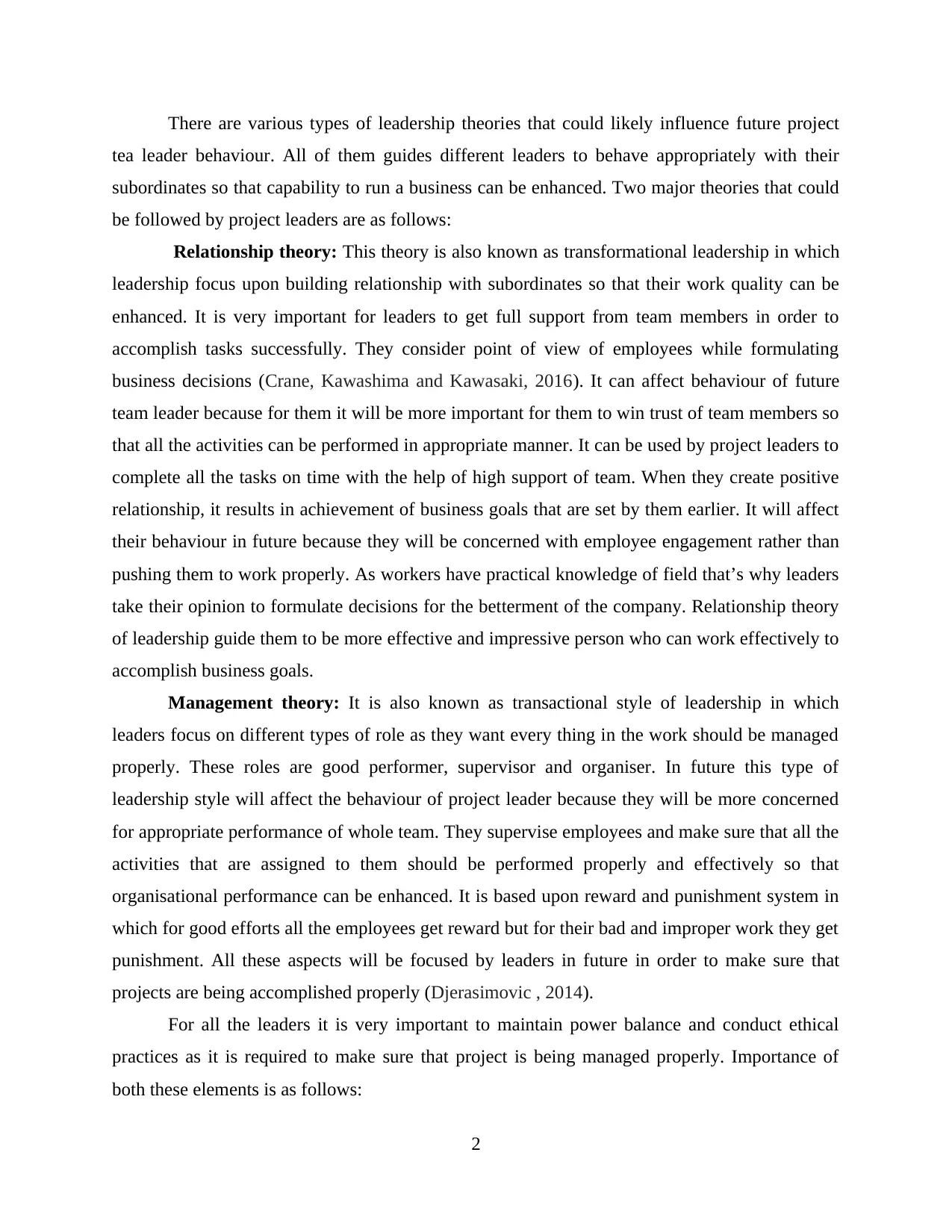
There are various types of leadership theories that could likely influence future project
tea leader behaviour. All of them guides different leaders to behave appropriately with their
subordinates so that capability to run a business can be enhanced. Two major theories that could
be followed by project leaders are as follows:
Relationship theory: This theory is also known as transformational leadership in which
leadership focus upon building relationship with subordinates so that their work quality can be
enhanced. It is very important for leaders to get full support from team members in order to
accomplish tasks successfully. They consider point of view of employees while formulating
business decisions (Crane, Kawashima and Kawasaki, 2016). It can affect behaviour of future
team leader because for them it will be more important for them to win trust of team members so
that all the activities can be performed in appropriate manner. It can be used by project leaders to
complete all the tasks on time with the help of high support of team. When they create positive
relationship, it results in achievement of business goals that are set by them earlier. It will affect
their behaviour in future because they will be concerned with employee engagement rather than
pushing them to work properly. As workers have practical knowledge of field that’s why leaders
take their opinion to formulate decisions for the betterment of the company. Relationship theory
of leadership guide them to be more effective and impressive person who can work effectively to
accomplish business goals.
Management theory: It is also known as transactional style of leadership in which
leaders focus on different types of role as they want every thing in the work should be managed
properly. These roles are good performer, supervisor and organiser. In future this type of
leadership style will affect the behaviour of project leader because they will be more concerned
for appropriate performance of whole team. They supervise employees and make sure that all the
activities that are assigned to them should be performed properly and effectively so that
organisational performance can be enhanced. It is based upon reward and punishment system in
which for good efforts all the employees get reward but for their bad and improper work they get
punishment. All these aspects will be focused by leaders in future in order to make sure that
projects are being accomplished properly (Djerasimovic , 2014).
For all the leaders it is very important to maintain power balance and conduct ethical
practices as it is required to make sure that project is being managed properly. Importance of
both these elements is as follows:
2
tea leader behaviour. All of them guides different leaders to behave appropriately with their
subordinates so that capability to run a business can be enhanced. Two major theories that could
be followed by project leaders are as follows:
Relationship theory: This theory is also known as transformational leadership in which
leadership focus upon building relationship with subordinates so that their work quality can be
enhanced. It is very important for leaders to get full support from team members in order to
accomplish tasks successfully. They consider point of view of employees while formulating
business decisions (Crane, Kawashima and Kawasaki, 2016). It can affect behaviour of future
team leader because for them it will be more important for them to win trust of team members so
that all the activities can be performed in appropriate manner. It can be used by project leaders to
complete all the tasks on time with the help of high support of team. When they create positive
relationship, it results in achievement of business goals that are set by them earlier. It will affect
their behaviour in future because they will be concerned with employee engagement rather than
pushing them to work properly. As workers have practical knowledge of field that’s why leaders
take their opinion to formulate decisions for the betterment of the company. Relationship theory
of leadership guide them to be more effective and impressive person who can work effectively to
accomplish business goals.
Management theory: It is also known as transactional style of leadership in which
leaders focus on different types of role as they want every thing in the work should be managed
properly. These roles are good performer, supervisor and organiser. In future this type of
leadership style will affect the behaviour of project leader because they will be more concerned
for appropriate performance of whole team. They supervise employees and make sure that all the
activities that are assigned to them should be performed properly and effectively so that
organisational performance can be enhanced. It is based upon reward and punishment system in
which for good efforts all the employees get reward but for their bad and improper work they get
punishment. All these aspects will be focused by leaders in future in order to make sure that
projects are being accomplished properly (Djerasimovic , 2014).
For all the leaders it is very important to maintain power balance and conduct ethical
practices as it is required to make sure that project is being managed properly. Importance of
both these elements is as follows:
2
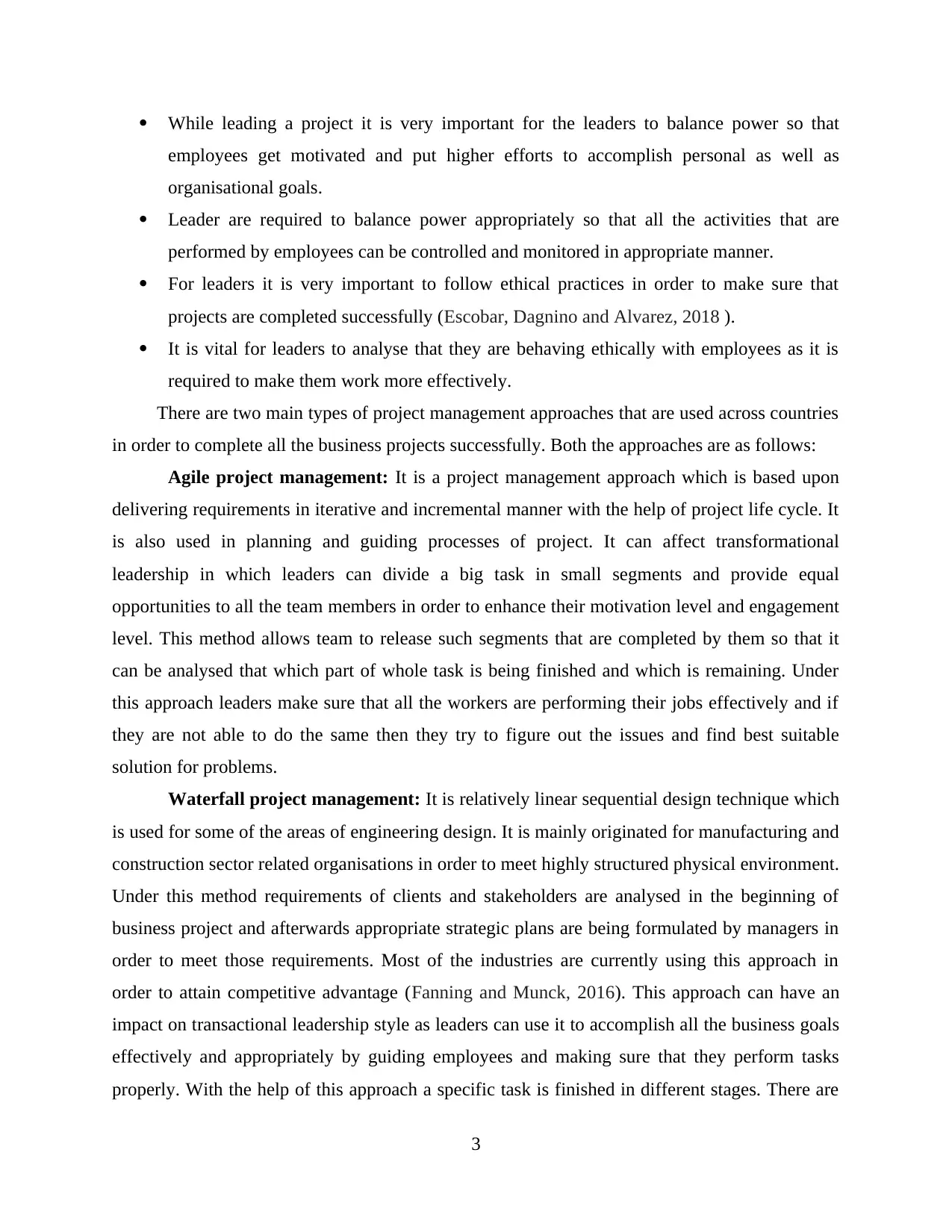
While leading a project it is very important for the leaders to balance power so that
employees get motivated and put higher efforts to accomplish personal as well as
organisational goals.
Leader are required to balance power appropriately so that all the activities that are
performed by employees can be controlled and monitored in appropriate manner.
For leaders it is very important to follow ethical practices in order to make sure that
projects are completed successfully (Escobar, Dagnino and Alvarez, 2018 ).
It is vital for leaders to analyse that they are behaving ethically with employees as it is
required to make them work more effectively.
There are two main types of project management approaches that are used across countries
in order to complete all the business projects successfully. Both the approaches are as follows:
Agile project management: It is a project management approach which is based upon
delivering requirements in iterative and incremental manner with the help of project life cycle. It
is also used in planning and guiding processes of project. It can affect transformational
leadership in which leaders can divide a big task in small segments and provide equal
opportunities to all the team members in order to enhance their motivation level and engagement
level. This method allows team to release such segments that are completed by them so that it
can be analysed that which part of whole task is being finished and which is remaining. Under
this approach leaders make sure that all the workers are performing their jobs effectively and if
they are not able to do the same then they try to figure out the issues and find best suitable
solution for problems.
Waterfall project management: It is relatively linear sequential design technique which
is used for some of the areas of engineering design. It is mainly originated for manufacturing and
construction sector related organisations in order to meet highly structured physical environment.
Under this method requirements of clients and stakeholders are analysed in the beginning of
business project and afterwards appropriate strategic plans are being formulated by managers in
order to meet those requirements. Most of the industries are currently using this approach in
order to attain competitive advantage (Fanning and Munck, 2016). This approach can have an
impact on transactional leadership style as leaders can use it to accomplish all the business goals
effectively and appropriately by guiding employees and making sure that they perform tasks
properly. With the help of this approach a specific task is finished in different stages. There are
3
employees get motivated and put higher efforts to accomplish personal as well as
organisational goals.
Leader are required to balance power appropriately so that all the activities that are
performed by employees can be controlled and monitored in appropriate manner.
For leaders it is very important to follow ethical practices in order to make sure that
projects are completed successfully (Escobar, Dagnino and Alvarez, 2018 ).
It is vital for leaders to analyse that they are behaving ethically with employees as it is
required to make them work more effectively.
There are two main types of project management approaches that are used across countries
in order to complete all the business projects successfully. Both the approaches are as follows:
Agile project management: It is a project management approach which is based upon
delivering requirements in iterative and incremental manner with the help of project life cycle. It
is also used in planning and guiding processes of project. It can affect transformational
leadership in which leaders can divide a big task in small segments and provide equal
opportunities to all the team members in order to enhance their motivation level and engagement
level. This method allows team to release such segments that are completed by them so that it
can be analysed that which part of whole task is being finished and which is remaining. Under
this approach leaders make sure that all the workers are performing their jobs effectively and if
they are not able to do the same then they try to figure out the issues and find best suitable
solution for problems.
Waterfall project management: It is relatively linear sequential design technique which
is used for some of the areas of engineering design. It is mainly originated for manufacturing and
construction sector related organisations in order to meet highly structured physical environment.
Under this method requirements of clients and stakeholders are analysed in the beginning of
business project and afterwards appropriate strategic plans are being formulated by managers in
order to meet those requirements. Most of the industries are currently using this approach in
order to attain competitive advantage (Fanning and Munck, 2016). This approach can have an
impact on transactional leadership style as leaders can use it to accomplish all the business goals
effectively and appropriately by guiding employees and making sure that they perform tasks
properly. With the help of this approach a specific task is finished in different stages. There are
3
⊘ This is a preview!⊘
Do you want full access?
Subscribe today to unlock all pages.

Trusted by 1+ million students worldwide
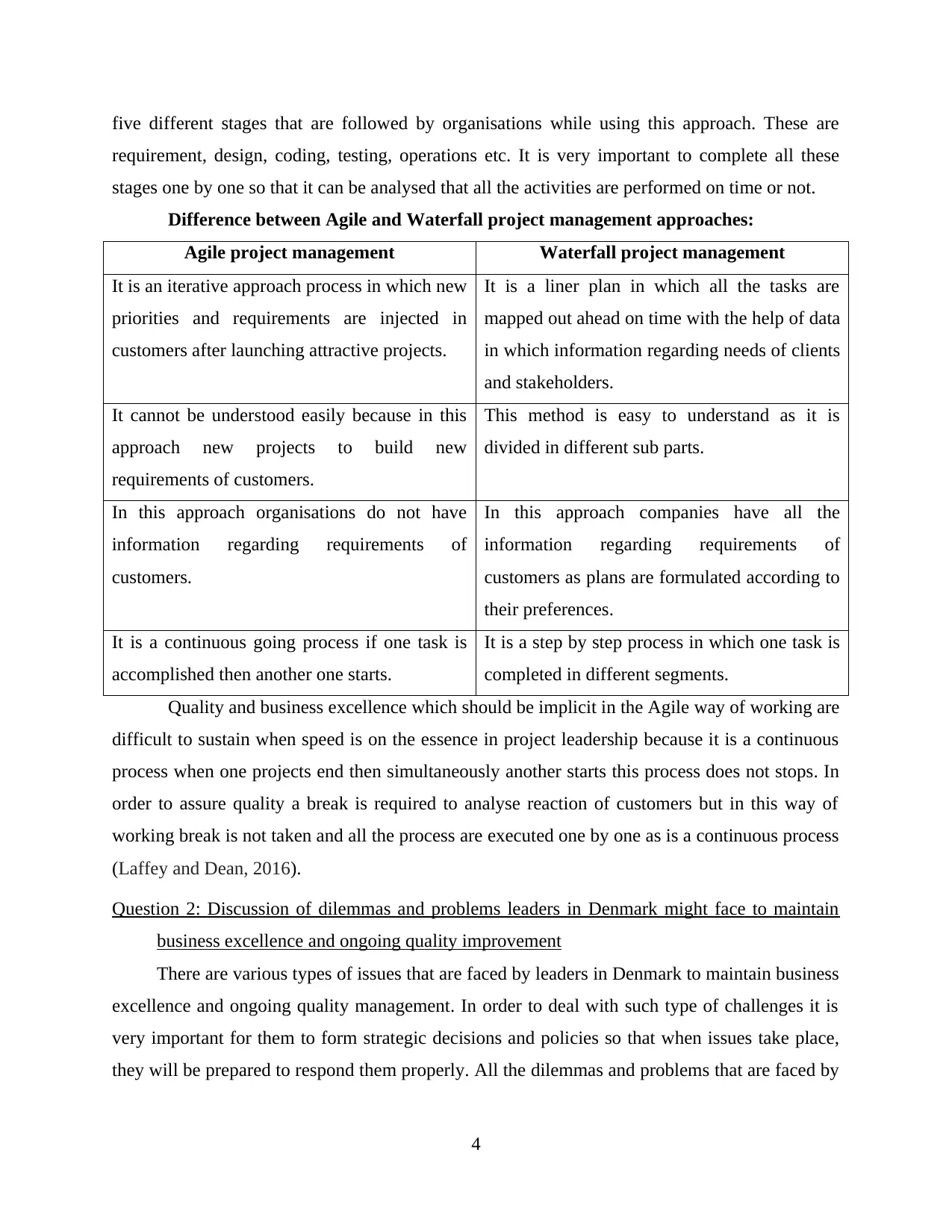
five different stages that are followed by organisations while using this approach. These are
requirement, design, coding, testing, operations etc. It is very important to complete all these
stages one by one so that it can be analysed that all the activities are performed on time or not.
Difference between Agile and Waterfall project management approaches:
Agile project management Waterfall project management
It is an iterative approach process in which new
priorities and requirements are injected in
customers after launching attractive projects.
It is a liner plan in which all the tasks are
mapped out ahead on time with the help of data
in which information regarding needs of clients
and stakeholders.
It cannot be understood easily because in this
approach new projects to build new
requirements of customers.
This method is easy to understand as it is
divided in different sub parts.
In this approach organisations do not have
information regarding requirements of
customers.
In this approach companies have all the
information regarding requirements of
customers as plans are formulated according to
their preferences.
It is a continuous going process if one task is
accomplished then another one starts.
It is a step by step process in which one task is
completed in different segments.
Quality and business excellence which should be implicit in the Agile way of working are
difficult to sustain when speed is on the essence in project leadership because it is a continuous
process when one projects end then simultaneously another starts this process does not stops. In
order to assure quality a break is required to analyse reaction of customers but in this way of
working break is not taken and all the process are executed one by one as is a continuous process
(Laffey and Dean, 2016).
Question 2: Discussion of dilemmas and problems leaders in Denmark might face to maintain
business excellence and ongoing quality improvement
There are various types of issues that are faced by leaders in Denmark to maintain business
excellence and ongoing quality management. In order to deal with such type of challenges it is
very important for them to form strategic decisions and policies so that when issues take place,
they will be prepared to respond them properly. All the dilemmas and problems that are faced by
4
requirement, design, coding, testing, operations etc. It is very important to complete all these
stages one by one so that it can be analysed that all the activities are performed on time or not.
Difference between Agile and Waterfall project management approaches:
Agile project management Waterfall project management
It is an iterative approach process in which new
priorities and requirements are injected in
customers after launching attractive projects.
It is a liner plan in which all the tasks are
mapped out ahead on time with the help of data
in which information regarding needs of clients
and stakeholders.
It cannot be understood easily because in this
approach new projects to build new
requirements of customers.
This method is easy to understand as it is
divided in different sub parts.
In this approach organisations do not have
information regarding requirements of
customers.
In this approach companies have all the
information regarding requirements of
customers as plans are formulated according to
their preferences.
It is a continuous going process if one task is
accomplished then another one starts.
It is a step by step process in which one task is
completed in different segments.
Quality and business excellence which should be implicit in the Agile way of working are
difficult to sustain when speed is on the essence in project leadership because it is a continuous
process when one projects end then simultaneously another starts this process does not stops. In
order to assure quality a break is required to analyse reaction of customers but in this way of
working break is not taken and all the process are executed one by one as is a continuous process
(Laffey and Dean, 2016).
Question 2: Discussion of dilemmas and problems leaders in Denmark might face to maintain
business excellence and ongoing quality improvement
There are various types of issues that are faced by leaders in Denmark to maintain business
excellence and ongoing quality management. In order to deal with such type of challenges it is
very important for them to form strategic decisions and policies so that when issues take place,
they will be prepared to respond them properly. All the dilemmas and problems that are faced by
4
Paraphrase This Document
Need a fresh take? Get an instant paraphrase of this document with our AI Paraphraser
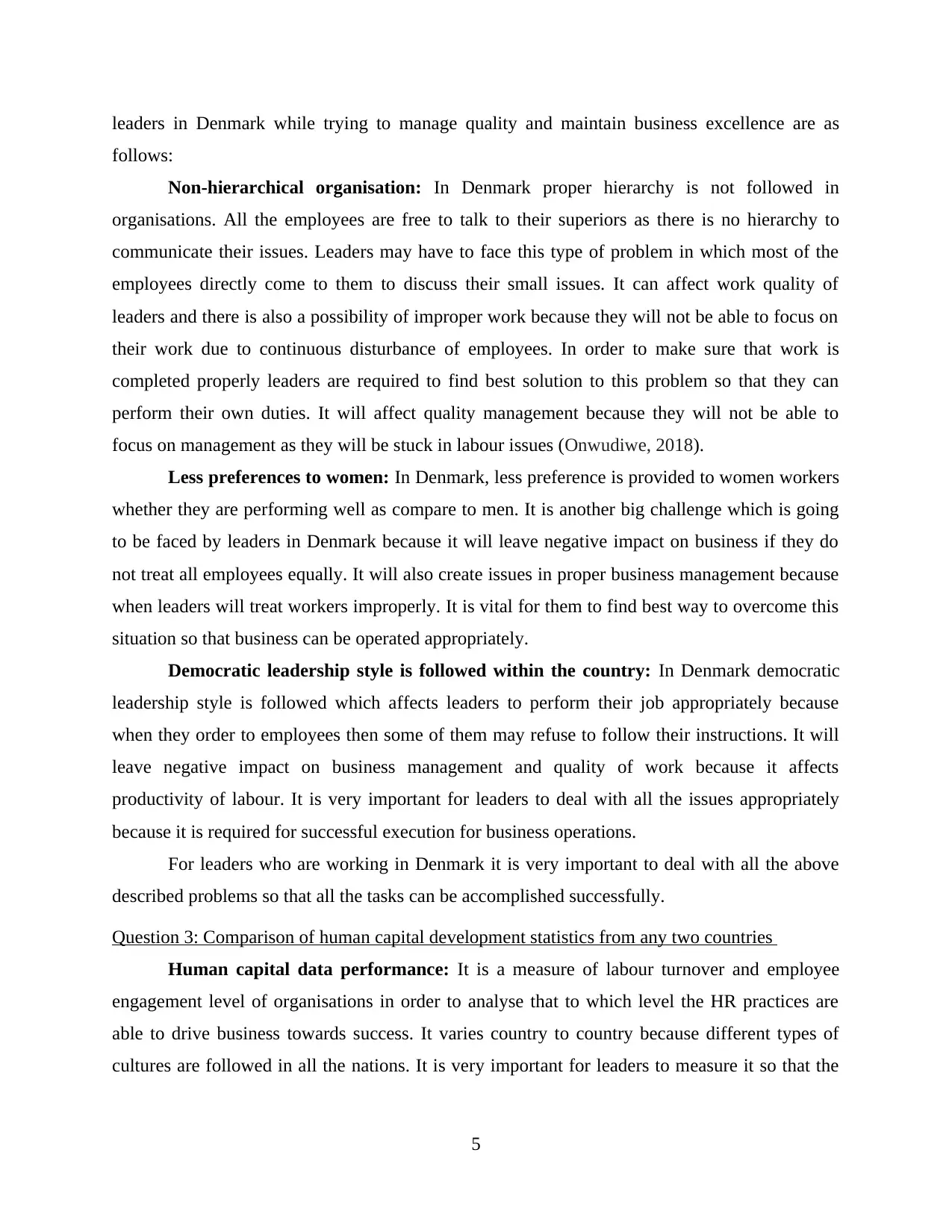
leaders in Denmark while trying to manage quality and maintain business excellence are as
follows:
Non-hierarchical organisation: In Denmark proper hierarchy is not followed in
organisations. All the employees are free to talk to their superiors as there is no hierarchy to
communicate their issues. Leaders may have to face this type of problem in which most of the
employees directly come to them to discuss their small issues. It can affect work quality of
leaders and there is also a possibility of improper work because they will not be able to focus on
their work due to continuous disturbance of employees. In order to make sure that work is
completed properly leaders are required to find best solution to this problem so that they can
perform their own duties. It will affect quality management because they will not be able to
focus on management as they will be stuck in labour issues (Onwudiwe, 2018).
Less preferences to women: In Denmark, less preference is provided to women workers
whether they are performing well as compare to men. It is another big challenge which is going
to be faced by leaders in Denmark because it will leave negative impact on business if they do
not treat all employees equally. It will also create issues in proper business management because
when leaders will treat workers improperly. It is vital for them to find best way to overcome this
situation so that business can be operated appropriately.
Democratic leadership style is followed within the country: In Denmark democratic
leadership style is followed which affects leaders to perform their job appropriately because
when they order to employees then some of them may refuse to follow their instructions. It will
leave negative impact on business management and quality of work because it affects
productivity of labour. It is very important for leaders to deal with all the issues appropriately
because it is required for successful execution for business operations.
For leaders who are working in Denmark it is very important to deal with all the above
described problems so that all the tasks can be accomplished successfully.
Question 3: Comparison of human capital development statistics from any two countries
Human capital data performance: It is a measure of labour turnover and employee
engagement level of organisations in order to analyse that to which level the HR practices are
able to drive business towards success. It varies country to country because different types of
cultures are followed in all the nations. It is very important for leaders to measure it so that the
5
follows:
Non-hierarchical organisation: In Denmark proper hierarchy is not followed in
organisations. All the employees are free to talk to their superiors as there is no hierarchy to
communicate their issues. Leaders may have to face this type of problem in which most of the
employees directly come to them to discuss their small issues. It can affect work quality of
leaders and there is also a possibility of improper work because they will not be able to focus on
their work due to continuous disturbance of employees. In order to make sure that work is
completed properly leaders are required to find best solution to this problem so that they can
perform their own duties. It will affect quality management because they will not be able to
focus on management as they will be stuck in labour issues (Onwudiwe, 2018).
Less preferences to women: In Denmark, less preference is provided to women workers
whether they are performing well as compare to men. It is another big challenge which is going
to be faced by leaders in Denmark because it will leave negative impact on business if they do
not treat all employees equally. It will also create issues in proper business management because
when leaders will treat workers improperly. It is vital for them to find best way to overcome this
situation so that business can be operated appropriately.
Democratic leadership style is followed within the country: In Denmark democratic
leadership style is followed which affects leaders to perform their job appropriately because
when they order to employees then some of them may refuse to follow their instructions. It will
leave negative impact on business management and quality of work because it affects
productivity of labour. It is very important for leaders to deal with all the issues appropriately
because it is required for successful execution for business operations.
For leaders who are working in Denmark it is very important to deal with all the above
described problems so that all the tasks can be accomplished successfully.
Question 3: Comparison of human capital development statistics from any two countries
Human capital data performance: It is a measure of labour turnover and employee
engagement level of organisations in order to analyse that to which level the HR practices are
able to drive business towards success. It varies country to country because different types of
cultures are followed in all the nations. It is very important for leaders to measure it so that the
5
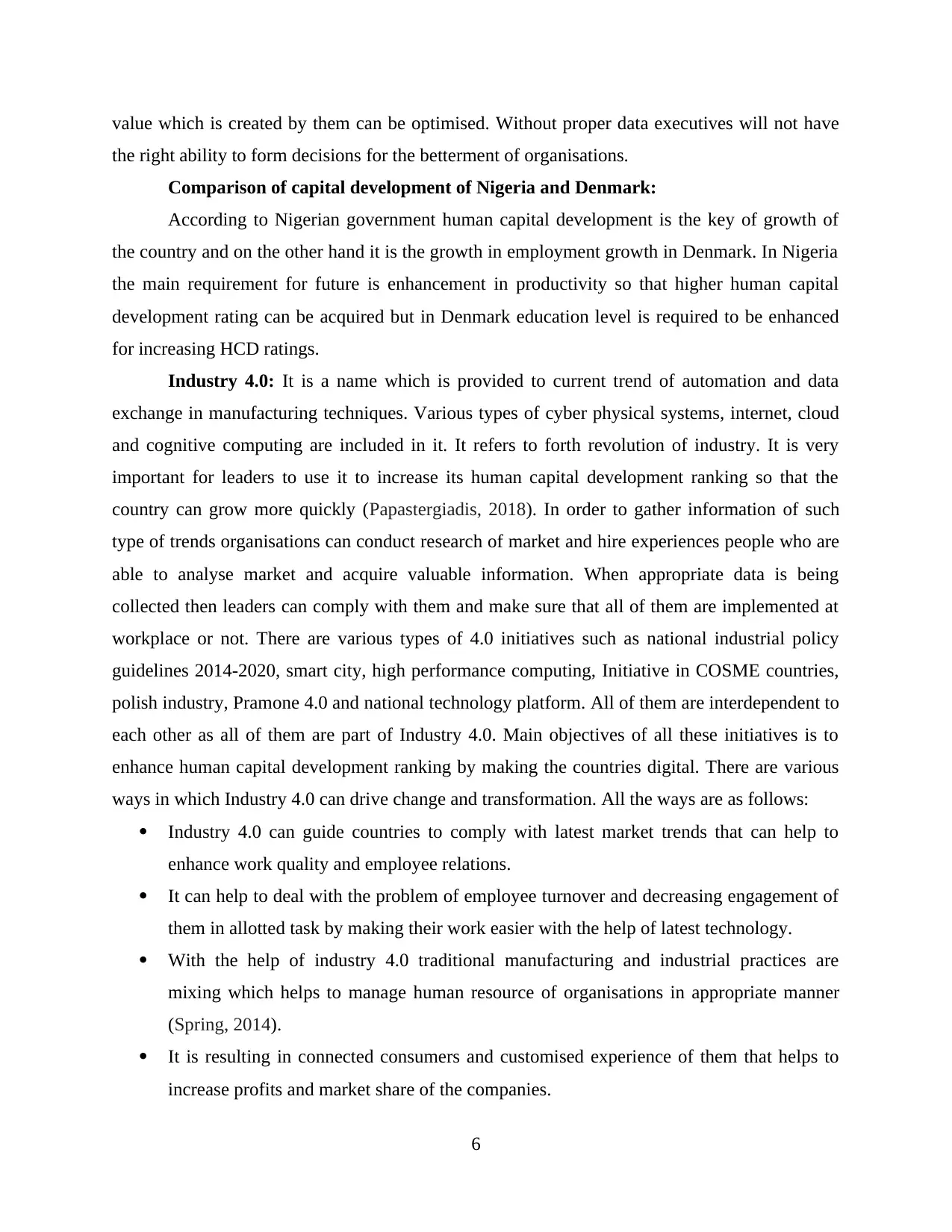
value which is created by them can be optimised. Without proper data executives will not have
the right ability to form decisions for the betterment of organisations.
Comparison of capital development of Nigeria and Denmark:
According to Nigerian government human capital development is the key of growth of
the country and on the other hand it is the growth in employment growth in Denmark. In Nigeria
the main requirement for future is enhancement in productivity so that higher human capital
development rating can be acquired but in Denmark education level is required to be enhanced
for increasing HCD ratings.
Industry 4.0: It is a name which is provided to current trend of automation and data
exchange in manufacturing techniques. Various types of cyber physical systems, internet, cloud
and cognitive computing are included in it. It refers to forth revolution of industry. It is very
important for leaders to use it to increase its human capital development ranking so that the
country can grow more quickly (Papastergiadis, 2018). In order to gather information of such
type of trends organisations can conduct research of market and hire experiences people who are
able to analyse market and acquire valuable information. When appropriate data is being
collected then leaders can comply with them and make sure that all of them are implemented at
workplace or not. There are various types of 4.0 initiatives such as national industrial policy
guidelines 2014-2020, smart city, high performance computing, Initiative in COSME countries,
polish industry, Pramone 4.0 and national technology platform. All of them are interdependent to
each other as all of them are part of Industry 4.0. Main objectives of all these initiatives is to
enhance human capital development ranking by making the countries digital. There are various
ways in which Industry 4.0 can drive change and transformation. All the ways are as follows:
Industry 4.0 can guide countries to comply with latest market trends that can help to
enhance work quality and employee relations.
It can help to deal with the problem of employee turnover and decreasing engagement of
them in allotted task by making their work easier with the help of latest technology.
With the help of industry 4.0 traditional manufacturing and industrial practices are
mixing which helps to manage human resource of organisations in appropriate manner
(Spring, 2014).
It is resulting in connected consumers and customised experience of them that helps to
increase profits and market share of the companies.
6
the right ability to form decisions for the betterment of organisations.
Comparison of capital development of Nigeria and Denmark:
According to Nigerian government human capital development is the key of growth of
the country and on the other hand it is the growth in employment growth in Denmark. In Nigeria
the main requirement for future is enhancement in productivity so that higher human capital
development rating can be acquired but in Denmark education level is required to be enhanced
for increasing HCD ratings.
Industry 4.0: It is a name which is provided to current trend of automation and data
exchange in manufacturing techniques. Various types of cyber physical systems, internet, cloud
and cognitive computing are included in it. It refers to forth revolution of industry. It is very
important for leaders to use it to increase its human capital development ranking so that the
country can grow more quickly (Papastergiadis, 2018). In order to gather information of such
type of trends organisations can conduct research of market and hire experiences people who are
able to analyse market and acquire valuable information. When appropriate data is being
collected then leaders can comply with them and make sure that all of them are implemented at
workplace or not. There are various types of 4.0 initiatives such as national industrial policy
guidelines 2014-2020, smart city, high performance computing, Initiative in COSME countries,
polish industry, Pramone 4.0 and national technology platform. All of them are interdependent to
each other as all of them are part of Industry 4.0. Main objectives of all these initiatives is to
enhance human capital development ranking by making the countries digital. There are various
ways in which Industry 4.0 can drive change and transformation. All the ways are as follows:
Industry 4.0 can guide countries to comply with latest market trends that can help to
enhance work quality and employee relations.
It can help to deal with the problem of employee turnover and decreasing engagement of
them in allotted task by making their work easier with the help of latest technology.
With the help of industry 4.0 traditional manufacturing and industrial practices are
mixing which helps to manage human resource of organisations in appropriate manner
(Spring, 2014).
It is resulting in connected consumers and customised experience of them that helps to
increase profits and market share of the companies.
6
⊘ This is a preview!⊘
Do you want full access?
Subscribe today to unlock all pages.

Trusted by 1+ million students worldwide
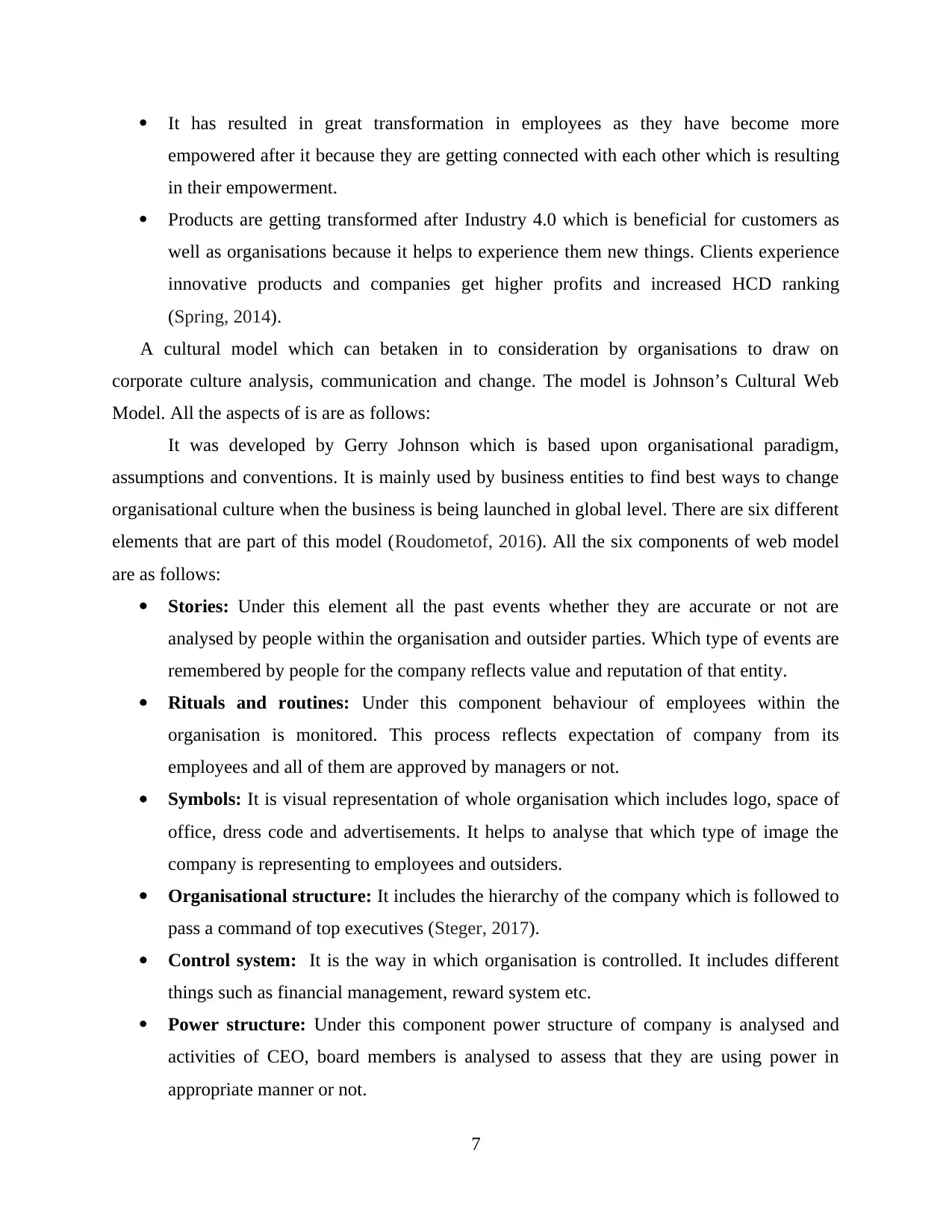
It has resulted in great transformation in employees as they have become more
empowered after it because they are getting connected with each other which is resulting
in their empowerment.
Products are getting transformed after Industry 4.0 which is beneficial for customers as
well as organisations because it helps to experience them new things. Clients experience
innovative products and companies get higher profits and increased HCD ranking
(Spring, 2014).
A cultural model which can betaken in to consideration by organisations to draw on
corporate culture analysis, communication and change. The model is Johnson’s Cultural Web
Model. All the aspects of is are as follows:
It was developed by Gerry Johnson which is based upon organisational paradigm,
assumptions and conventions. It is mainly used by business entities to find best ways to change
organisational culture when the business is being launched in global level. There are six different
elements that are part of this model (Roudometof, 2016). All the six components of web model
are as follows:
Stories: Under this element all the past events whether they are accurate or not are
analysed by people within the organisation and outsider parties. Which type of events are
remembered by people for the company reflects value and reputation of that entity.
Rituals and routines: Under this component behaviour of employees within the
organisation is monitored. This process reflects expectation of company from its
employees and all of them are approved by managers or not.
Symbols: It is visual representation of whole organisation which includes logo, space of
office, dress code and advertisements. It helps to analyse that which type of image the
company is representing to employees and outsiders.
Organisational structure: It includes the hierarchy of the company which is followed to
pass a command of top executives (Steger, 2017).
Control system: It is the way in which organisation is controlled. It includes different
things such as financial management, reward system etc.
Power structure: Under this component power structure of company is analysed and
activities of CEO, board members is analysed to assess that they are using power in
appropriate manner or not.
7
empowered after it because they are getting connected with each other which is resulting
in their empowerment.
Products are getting transformed after Industry 4.0 which is beneficial for customers as
well as organisations because it helps to experience them new things. Clients experience
innovative products and companies get higher profits and increased HCD ranking
(Spring, 2014).
A cultural model which can betaken in to consideration by organisations to draw on
corporate culture analysis, communication and change. The model is Johnson’s Cultural Web
Model. All the aspects of is are as follows:
It was developed by Gerry Johnson which is based upon organisational paradigm,
assumptions and conventions. It is mainly used by business entities to find best ways to change
organisational culture when the business is being launched in global level. There are six different
elements that are part of this model (Roudometof, 2016). All the six components of web model
are as follows:
Stories: Under this element all the past events whether they are accurate or not are
analysed by people within the organisation and outsider parties. Which type of events are
remembered by people for the company reflects value and reputation of that entity.
Rituals and routines: Under this component behaviour of employees within the
organisation is monitored. This process reflects expectation of company from its
employees and all of them are approved by managers or not.
Symbols: It is visual representation of whole organisation which includes logo, space of
office, dress code and advertisements. It helps to analyse that which type of image the
company is representing to employees and outsiders.
Organisational structure: It includes the hierarchy of the company which is followed to
pass a command of top executives (Steger, 2017).
Control system: It is the way in which organisation is controlled. It includes different
things such as financial management, reward system etc.
Power structure: Under this component power structure of company is analysed and
activities of CEO, board members is analysed to assess that they are using power in
appropriate manner or not.
7
Paraphrase This Document
Need a fresh take? Get an instant paraphrase of this document with our AI Paraphraser
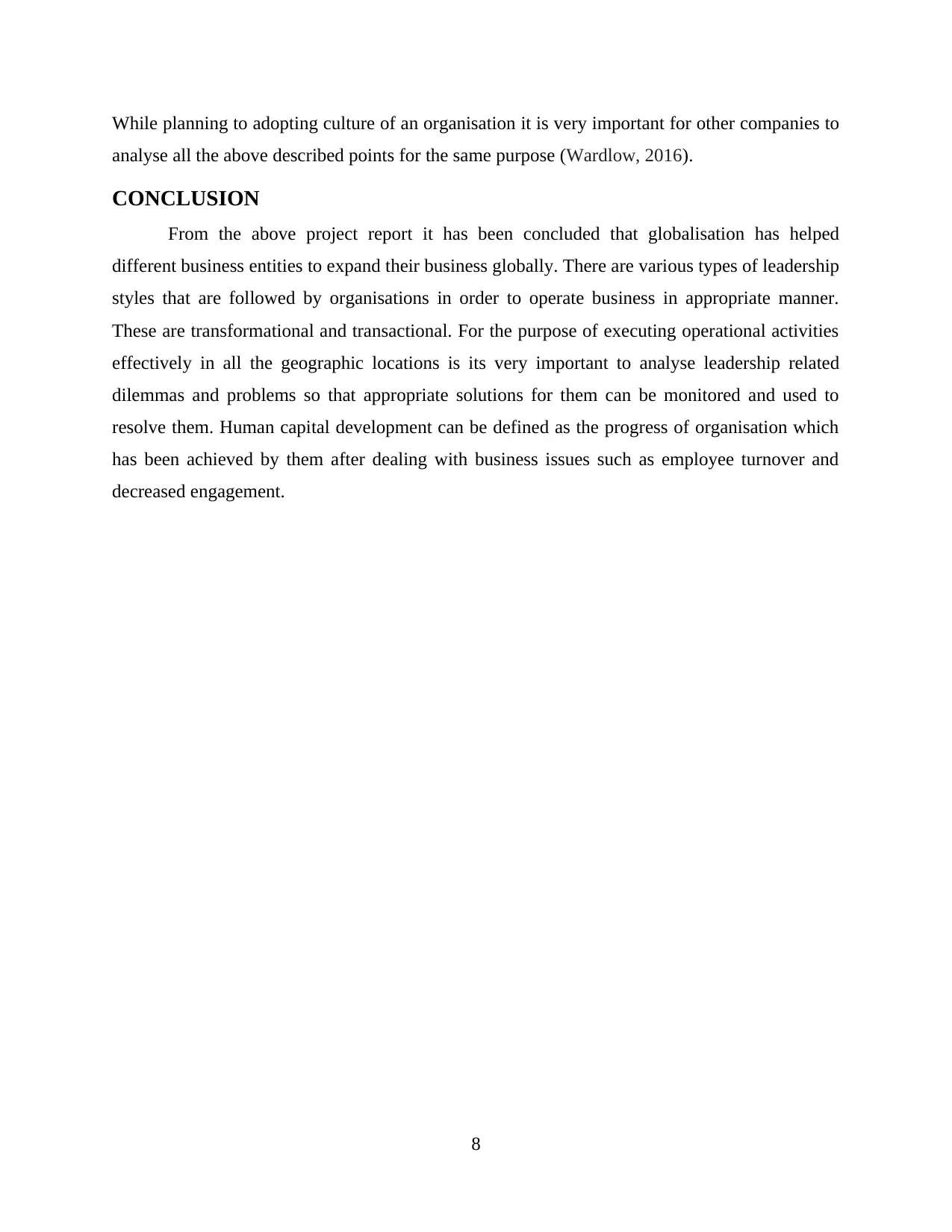
While planning to adopting culture of an organisation it is very important for other companies to
analyse all the above described points for the same purpose (Wardlow, 2016).
CONCLUSION
From the above project report it has been concluded that globalisation has helped
different business entities to expand their business globally. There are various types of leadership
styles that are followed by organisations in order to operate business in appropriate manner.
These are transformational and transactional. For the purpose of executing operational activities
effectively in all the geographic locations is its very important to analyse leadership related
dilemmas and problems so that appropriate solutions for them can be monitored and used to
resolve them. Human capital development can be defined as the progress of organisation which
has been achieved by them after dealing with business issues such as employee turnover and
decreased engagement.
8
analyse all the above described points for the same purpose (Wardlow, 2016).
CONCLUSION
From the above project report it has been concluded that globalisation has helped
different business entities to expand their business globally. There are various types of leadership
styles that are followed by organisations in order to operate business in appropriate manner.
These are transformational and transactional. For the purpose of executing operational activities
effectively in all the geographic locations is its very important to analyse leadership related
dilemmas and problems so that appropriate solutions for them can be monitored and used to
resolve them. Human capital development can be defined as the progress of organisation which
has been achieved by them after dealing with business issues such as employee turnover and
decreased engagement.
8
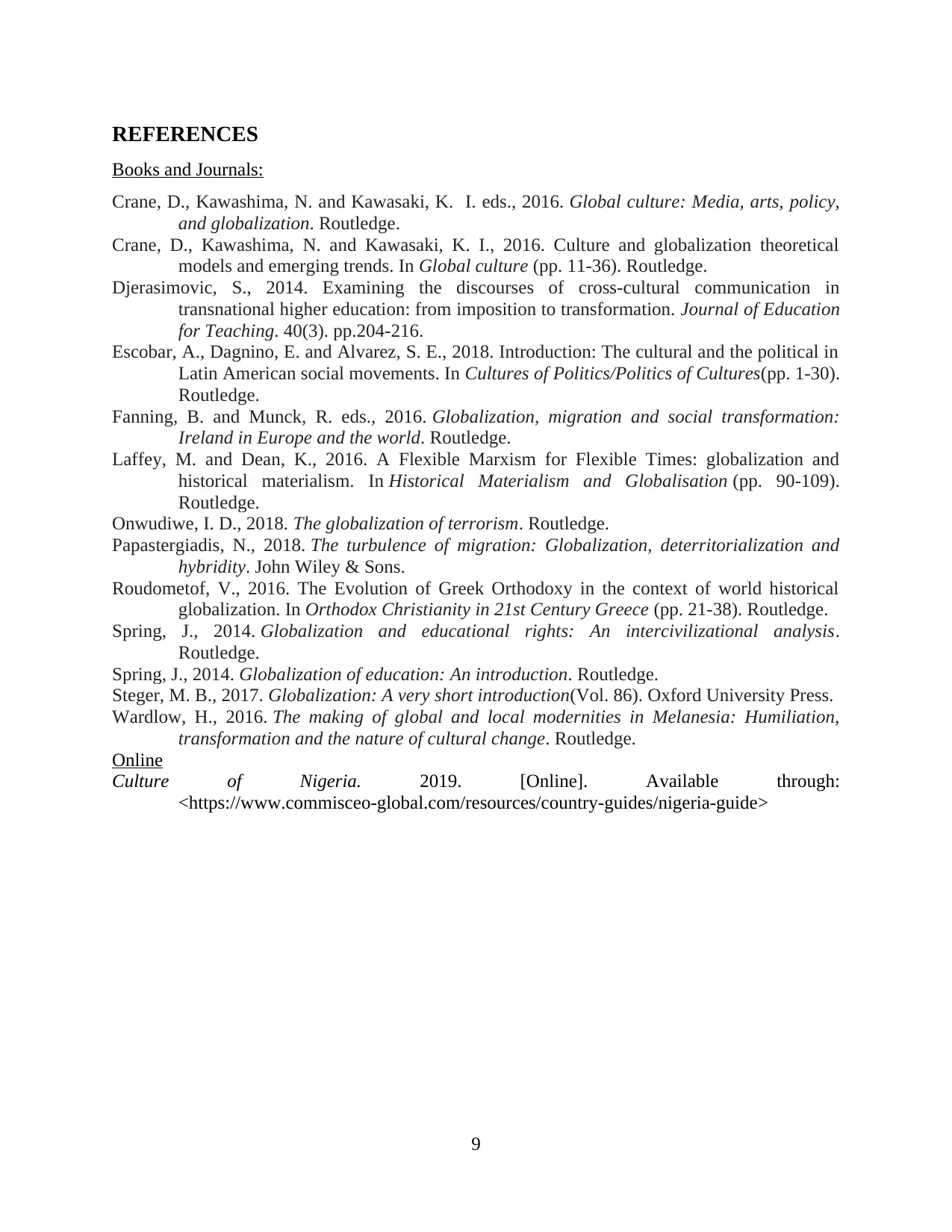
REFERENCES
Books and Journals:
Crane, D., Kawashima, N. and Kawasaki, K. I. eds., 2016. Global culture: Media, arts, policy,
and globalization. Routledge.
Crane, D., Kawashima, N. and Kawasaki, K. I., 2016. Culture and globalization theoretical
models and emerging trends. In Global culture (pp. 11-36). Routledge.
Djerasimovic, S., 2014. Examining the discourses of cross-cultural communication in
transnational higher education: from imposition to transformation. Journal of Education
for Teaching. 40(3). pp.204-216.
Escobar, A., Dagnino, E. and Alvarez, S. E., 2018. Introduction: The cultural and the political in
Latin American social movements. In Cultures of Politics/Politics of Cultures(pp. 1-30).
Routledge.
Fanning, B. and Munck, R. eds., 2016. Globalization, migration and social transformation:
Ireland in Europe and the world. Routledge.
Laffey, M. and Dean, K., 2016. A Flexible Marxism for Flexible Times: globalization and
historical materialism. In Historical Materialism and Globalisation (pp. 90-109).
Routledge.
Onwudiwe, I. D., 2018. The globalization of terrorism. Routledge.
Papastergiadis, N., 2018. The turbulence of migration: Globalization, deterritorialization and
hybridity. John Wiley & Sons.
Roudometof, V., 2016. The Evolution of Greek Orthodoxy in the context of world historical
globalization. In Orthodox Christianity in 21st Century Greece (pp. 21-38). Routledge.
Spring, J., 2014. Globalization and educational rights: An intercivilizational analysis.
Routledge.
Spring, J., 2014. Globalization of education: An introduction. Routledge.
Steger, M. B., 2017. Globalization: A very short introduction(Vol. 86). Oxford University Press.
Wardlow, H., 2016. The making of global and local modernities in Melanesia: Humiliation,
transformation and the nature of cultural change. Routledge.
Online
Culture of Nigeria. 2019. [Online]. Available through:
<https://www.commisceo-global.com/resources/country-guides/nigeria-guide>
9
Books and Journals:
Crane, D., Kawashima, N. and Kawasaki, K. I. eds., 2016. Global culture: Media, arts, policy,
and globalization. Routledge.
Crane, D., Kawashima, N. and Kawasaki, K. I., 2016. Culture and globalization theoretical
models and emerging trends. In Global culture (pp. 11-36). Routledge.
Djerasimovic, S., 2014. Examining the discourses of cross-cultural communication in
transnational higher education: from imposition to transformation. Journal of Education
for Teaching. 40(3). pp.204-216.
Escobar, A., Dagnino, E. and Alvarez, S. E., 2018. Introduction: The cultural and the political in
Latin American social movements. In Cultures of Politics/Politics of Cultures(pp. 1-30).
Routledge.
Fanning, B. and Munck, R. eds., 2016. Globalization, migration and social transformation:
Ireland in Europe and the world. Routledge.
Laffey, M. and Dean, K., 2016. A Flexible Marxism for Flexible Times: globalization and
historical materialism. In Historical Materialism and Globalisation (pp. 90-109).
Routledge.
Onwudiwe, I. D., 2018. The globalization of terrorism. Routledge.
Papastergiadis, N., 2018. The turbulence of migration: Globalization, deterritorialization and
hybridity. John Wiley & Sons.
Roudometof, V., 2016. The Evolution of Greek Orthodoxy in the context of world historical
globalization. In Orthodox Christianity in 21st Century Greece (pp. 21-38). Routledge.
Spring, J., 2014. Globalization and educational rights: An intercivilizational analysis.
Routledge.
Spring, J., 2014. Globalization of education: An introduction. Routledge.
Steger, M. B., 2017. Globalization: A very short introduction(Vol. 86). Oxford University Press.
Wardlow, H., 2016. The making of global and local modernities in Melanesia: Humiliation,
transformation and the nature of cultural change. Routledge.
Online
Culture of Nigeria. 2019. [Online]. Available through:
<https://www.commisceo-global.com/resources/country-guides/nigeria-guide>
9
⊘ This is a preview!⊘
Do you want full access?
Subscribe today to unlock all pages.

Trusted by 1+ million students worldwide
1 out of 12
Your All-in-One AI-Powered Toolkit for Academic Success.
+13062052269
info@desklib.com
Available 24*7 on WhatsApp / Email
![[object Object]](/_next/static/media/star-bottom.7253800d.svg)
Unlock your academic potential
Copyright © 2020–2025 A2Z Services. All Rights Reserved. Developed and managed by ZUCOL.


